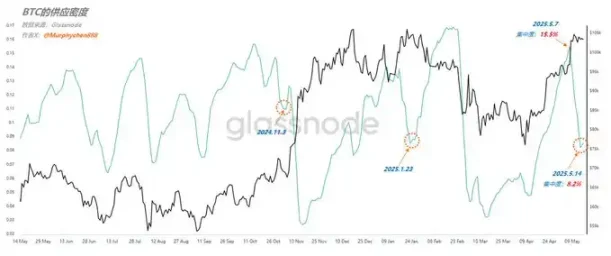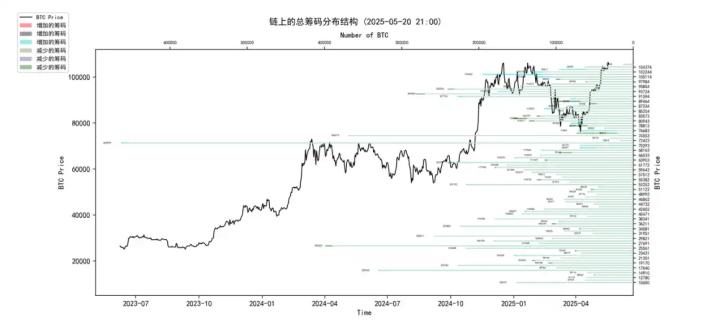In summary, the current concentration curve does not smoothly decline but instead pauses midway, bringing uncertainty to the market direction. Through this indicator, we can hardly guess whether to long or short; it only tells us that the market may be about to choose a direction.
However, when the concentration rises to a certain height, considering longing volatility would be a good choice.

Institutional Observations
CryptoQuant: No Signs of Market Overheating
Whenever the token price experiences a strong surge, causing many previously loss-making tokens to quickly turn profitable, the 30-day Simple Moving Average (SMA) of Unspent Transaction Output (UTXO) profit and loss ratio rises above 200. The higher this indicator soars, the closer the market is to an "overheated" or "selling pressure release" stage.
Currently, this indicator is at 99, so there are no signs of market overheating. If this moving average continues to break through 200, it will be a clear signal that market sentiment is entering a new frenzy. In other words, the market may still continue to reach new highs, but the "easy fuel" driving the profit and loss ratio up has basically been exhausted. Subsequent stronger price momentum or dramatic fluctuations will be needed to push this indicator higher again.
As I said yesterday, the third "compression period" of this cycle is the key driving force to push this indicator beyond 200 and enter the overheated stage.
Matrixport: Spot Buying Driven, Long-term Funds Gradually Replacing Short-term Speculation
Bitcoin's trend is repeating historical patterns: as the price approaches a new high, open interest also rises to a historical peak of $34 billion. However, the funding rate remains close to zero. This indicates that the current trend is driven by spot buying, not leveraged contracts.
The low funding rate means limited market speculation bubble and lower risk of violent pullbacks caused by leverage. As a result, volatility remains low in this cycle, with a low probability of significant short-term fluctuations.
The Bitcoin market structure is evolving, with long-term funds gradually replacing short-term speculation as the main driving force.
10x Research: Long-term Holders' Coin Holdings Continue to Rise, Cycle Not Yet Ended
On-chain data analysis shows that in 2025, Bitcoin's "OG" wallets—early investors, miners, and veteran exchanges—have been continuously distributing Bitcoin. This is not panic selling but a planned, rhythmic asset rotation. Bitcoin is steadily flowing to high-net-worth individuals, hedge funds, and corporate treasuries like MicroStrategy. Meanwhile, platform deposit volumes remain low, and market volatility is suppressed. This round is not a rapid rise driven by retail investor impulse like in 2017 or 2021.
This trend is slow, strategic, and institution-led. As long as large players can continue to absorb selling pressure, Bitcoin still has room to rise. Bitcoin's historical pattern shows that the real risk is not when long-term holders start selling, but when they stop selling. That's when demand begins to weaken, absorption fails, and early investors are forced back to being "passive holders". This scenario was seen in March 2024 and January 2025. Both signals were clear—we also timely turned short at those times.
Now, long-term holders' coin holdings are still rising, indicating that this cycle is not yet over. We accurately predicted Bitcoin breaking $84,500, then rising to $95,000 and $106,000. Our next target is $122,000, still based on our macro cycle and behavioral capital flow analysis models that have successfully identified major turning points multiple times.
QCP: Further FOMO After New Highs
The 30-year Japanese Government Bond (JGB) yield broke through 3%, crossing a historical threshold. Japan's continuously inflating debt problem has long been a potential concern and is now approaching a critical point. If this bond sell-off continues and fiscal concerns escalate, a short-term revaluation of Japanese risk might drive the yen's appreciation. Japanese market volatility is already affecting global markets. The U.S. 30-year Treasury yield has again broken through 5%, with investors turning their attention to the U.S.'s own debt trajectory.
Meanwhile, Bitcoin attempted to break the $108,000 mark today but failed to maintain momentum. The current price trend is closely related to Strategy and Metaplanet's increased holdings, which remain the primary buying sources. However, the market is increasingly concerned that they might represent the last wave of "marginal buyers". If their purchases slow down, it could trigger other investors to take profits, reversing the current upward trend.
Despite ongoing macro headwinds, including soaring bond yields, escalating tariffs, and potential stagflation risks in the U.S. in the third and fourth quarters of 2024, Bitcoin has shown remarkable resilience in the past month. Nevertheless, once the price successfully breaks the historical high, it might trigger a new round of FOMO, pulling sideline observing funds into the market and further pushing up the coin price.








